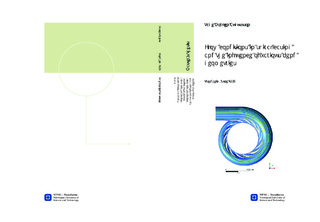| dc.description.abstract | Both previous experiments and CFD simulations show that bends have a significant influence on the downstream flow field, especially by causing so-called ?skewed velocity profiles?. Based on the simulations carried out in OpenFOAM during this thesis, the axial velocity profiles downstream of bends of a few selected geometries have been plotted and described in more detail than what the author has managed to find in previous work. The findings were divided into characteristics of velocity profiles in ?Plane AA? and ?Plane BB?, which are defined in Figure 2.1, while the bend simulations were carried out on four different bend geometries of two different angles and two different relative radiuses, which are listed in Table 4.1.In general, it was found that a sharper bend angle and a smaller relative radius lead to more skewness in the velocity profiles. Bends with small relative radiuses also tend to have sharper convective velocity gradients, i.e. sharper change in velocity over change in position, especially shortly after the outlet of the bend.In the case of the 45 degree bend (relatively small bend angle), the influence of using various relative radiuses (e.g. R/r=2 vs. R/r=8) seemed to make less impact on the velocity field skewness than that of the 90 degree bend. A number of simulations were carried out on a mesh of the NTNU Tokke spiral casing model, using ANSYS for meshing and CFX for simulation and post-processing. Radial velocity profiles at the outlet of the stay vanes were plotted against the angular position at the outlet. As expected due to the effect of the14stay vanes on the velocity distribution, the velocity field appeared divided into 14 velocity profile ?peaks?(see Figure 5.4.3.2a and b), each corresponding to one of the 14 stay vane channels that the water passes through on its way towards the guide vanes, and eventually into the runner.Based on the plots of the radial velocity components, it appears that the general shape of each velocity profile looks like a single, skewed and ?fang-shaped? peak. The fang-shape of each profile iscaused by a skewness leaning towards the inner curveof the channel curvature, where the gradient of the radial velocity over angular location (𝜕𝑢/𝜕𝜃) is larger at the inner part of the channel than at the outer part. This phenomenon is very similar to the skewed velocity profile in Plane AA that occurs shortly after a flow field enters the inlet of a bend, before it switches and starts skewing towards the side corresponding to the outer curve of the bend curvature.Although the spiral casing and stay vane design of the Tokke spiral casing model successfully achieves similar radial velocity profile shapes from each channel, the magnitude of the velocities, and thus the volumetric flow, going through each channel, varies more than what should be optimal. E.g., the peak velocities going through the first and the last channel. which are the channels with the lowest and highest peak velocity, respectively, have an absolute velocity difference of about 25%. | nb_NO |

